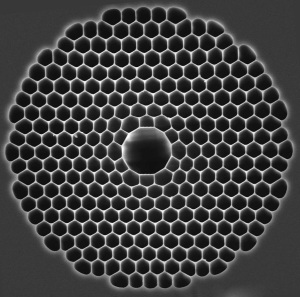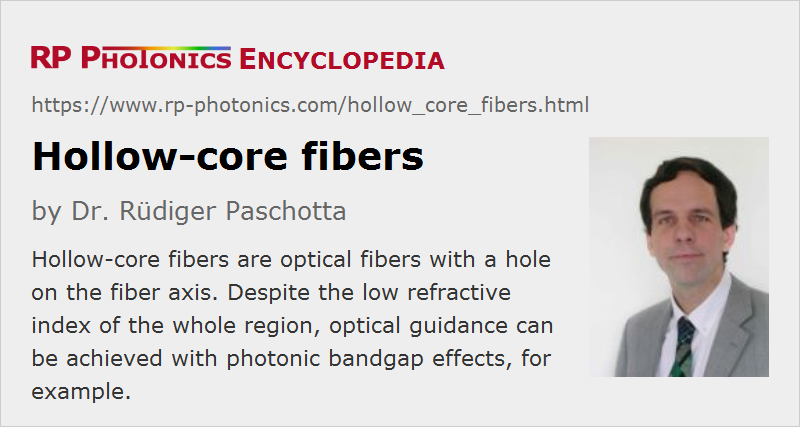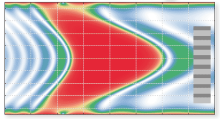Hollow-core Fibers
Acronym: HC fibers
Definition: optical fibers with a hole on the fiber axis
More general term: optical fibers
German: Fasern mit hohlem Kern
Category: fiber optics and waveguides
How to cite the article; suggest additional literature
Author: Dr. Rüdiger Paschotta
A hollow-core fiber is an optical fiber which guides light essentially within a hollow region, so that only a minor portion of the optical power propagates in the solid fiber material (typically a glass). According to the standard physical mechanism for guiding light in a fiber, this should not be possible: normally, the refractive index of the fiber core has to be higher than that of the surrounding cladding material, and there is no way of obtaining a refractive index of glass below that of air or vacuum, at least in the optical spectral region. However, other guiding mechanism can be used:
- One possibility is to exploit a photonic band gap, as can be realized in a photonic crystal fiber with a certain structure. Such fibers are also called photonic bandgap fibers. (Note that not all photonic bandgap fibers have a hollow core.)
- A particularly simple design (also leading to simplified production) is that of the revolver hollow-core fibers [12, 21] containing a pattern of silica rings (with circular or elliptical cross-section) around the hollow core; those are not using a photonic bandgap and cannot be considered as photonic crystal fibers. The fiber preform can be made relatively simply by arranging a number of silica capillaries, and these result in thin glass membranes after drawing into a fiber. A more refined version contains additional smaller rings nested within the larger rings [20, 29], and can provide further reduced propagation loss. A loss reduction can also be achieved already by slightly separating the tubes, avoiding nodes where they would touch each other. The term negative curvature fibers underlines the boundary curvature in a direction opposite that to a ring around the core. Other terms, containing the attribute antiresonant, emphasize the aspect of loss reduction by designing the glass structure for optical anti-resonance, i.e., suitable relative phase changes for reflection at different interfaces.

- Another example for negative curvature fibers is the Kagomé fiber [2, 14], featuring a hypocycloid core-cladding boundary.
Often, such fibers feature a very low overlap of the optical mode field with the solid structure, so that the light propagates mostly in air. The name air-guiding fibers is also used as a general term for hollow-core fibers, but is less precise, because it is actually not the air which provides the guidance.
Many hollow-core fibers, particularly those not based on a photonic band gap but rather on simpler anti-resonance structures, have a relatively large hollow core – with a diameter or e.g. 30 times the optical wavelength – and correspondingly large effective mode areas.
Special Properties
Various special properties of hollow-core fibers are relevant for different types of applications:
Wavelength Range with Guiding

The wavelength range in which the photonic bandgap guiding mechanism works is normally quite limited. That can be a limitation for some applications, while it can be exploited for others – for example, for suppressing the propagation of unwanted (e.g. Raman-shifted) light.
That wavelength range with light guidance can be substantially broadened by using a hollow-core fiber with a so-called Kagomé lattice design [2, 14]. That can be useful for supercontinuum generation [10], for example. The operation principle of the Kagome fiber design profoundly differs from that of a photonic bandgap fiber; it does not rely on a photonics bandgap [7, 9, 19]. Some optical properties also differ substantially from those of photonic bandgap fibers. For example, the slope of the chromatic dispersion is lower, which is beneficial for pulse compression [11, 16, 17]. Some designs (particularly those with large mode areas) exhibit a very small overlap of light with the silica structures (order of 0.01%), allowing the guidance of beams with rather high optical peak powers.
Propagation Loss
The propagation losses of hollow-core fibers are usually substantially higher than for solid-core fibers – in particular when single-mode guidance is required. There are, however, methods to mitigate that trade-off [15]. Recently, some hollow-core fibers with much reduced losses – roughly comparable to those of state-of-the-art silica fibers with a solid core in the optimum wavelength region around 1.5 μm, have been achieved [31]. Similarly low losses appear to be possible in a wider wavelength region, where silica absorption or scattering is substantially higher.
The low overlap of the intensity profile with the glass makes it possible even to guide light at wavelengths where the transparency of the glass material is relatively poor. For example, this has been demonstrated with high-energy pulses from an Er:YAG laser at 2.94 μm [13]. Even light from CO2 lasers at 10.6 μm can be guided with such fibers [3]. Hollow-core fibers are thus interesting for high power beam delivery in a wide range of wavelengths.
Weak Nonlinearities
The fact that light is primarily guided in air, having only a weak spatial overlap with the glass structure, minimizes nonlinear effects (particularly for ultrashort pulses with high peak power) and makes possible a high damage threshold. Note that the Kerr effect in air is about three orders of magnitude weaker than in glass, mostly due to the low density.
Chromatic Dispersion
Chromatic dispersion of such fibers can be engineered via the fiber design, particularly for photonic bandgap fibers with small mode area. This is also particularly interesting for guiding ultrashort pulses, where substantial amounts of chromatic dispersion and nonlinearity could lead to severe pulse distortions.
Fibers with a large hollow core typically exhibit quite weak chromatic dispersion, with little dependence on the design details. That can also be useful for delivering ultrashort pulses, for example.
High Group Velocity, Low Latency Signal Transmission
The group velocity of guided light is usually close to the vacuum velocity of light. This implies substantially lower latency for signal transmission through hollow-core fibers.
Raman Interactions in Gases
One may also exploit the high optical intensity in air or in some other gas filled into the fiber – for example, for realizing Raman lasers [5] or for high harmonic generation [8].
Reduced Coupling to Laser-active Dopants
In some cases, it is useful to have a low overlap of the optical field with the laser-active dopant in a rare-earth doped fiber. For example, this can help to realize a 978-nm Yb-doped fiber laser or fiber amplifier, where it is otherwise more difficult to suppress unwanted emission at longer wavelengths [27].
Main Applications
The envisaged main application areas of hollow-core fibers are the following:
- They can be used for delivering laser radiation, for example with high average power in wide wavelength regions from the ultraviolet to the mid infrared, or for radiation in the form of ultrashort pulses with high peak power.
- They may be useful for data transmission, particularly in cases where a very low latency (time delay) is vital. Also, one may exploit low-loss data transmission in spectral regions where the absorption losses of solid-core silica fibers are too high. By transmitting light with an overall substantially larger optical bandwidth, one may realize higher transmission capacities in terms of data rate.
- Miniature Raman lasers based on gases can be realized, because the interaction of a light beam guided by a hollow fiber is far more intense than that of a free-space beam in a multipass gas cell. Similarly, a number of other nonlinear functions can be realized with gas-filled hollow fibers [30].
Note that although the development of hollow-core fibers started a longer while ago, it took substantial time to develop the technology such that it became suitable for applications. Therefore, it remains to be seen which application areas will be particularly important, and which further applications can be developed.
Suppliers
The RP Photonics Buyer's Guide contains 9 suppliers for hollow-core fibers. Among them:


NKT Photonics
Our Crystal Fiber portfolio of specialty fibers spans from nonlinear fibers optimized for octave spanning supercontinuum generation, over the World’s largest single mode ytterbium gain fibers for high power lasers and amplifiers, to advanced hollow core fibers guiding the light in air. Our single-mode LMA fibers are also available as patch cords with standard termination in our aeroGUIDE product range. Moreover, we offer the CONNECT broadband fiber delivery system, enabling easy and robust single mode coupling for fiber delivery at any wavelength – with the industry’s highest coupling efficiency.
Questions and Comments from Users
Here you can submit questions and comments. As far as they get accepted by the author, they will appear above this paragraph together with the author’s answer. The author will decide on acceptance based on certain criteria. Essentially, the issue must be of sufficiently broad interest.
Please do not enter personal data here; we would otherwise delete it soon. (See also our privacy declaration.) If you wish to receive personal feedback or consultancy from the author, please contact him e.g. via e-mail.
By submitting the information, you give your consent to the potential publication of your inputs on our website according to our rules. (If you later retract your consent, we will delete those inputs.) As your inputs are first reviewed by the author, they may be published with some delay.
Bibliography
| [1] | R. F. Cregan et al., “Single-mode photonic band gap guidance of light in air”, Science 285, 1537 (1999) (first hollow-core PCF), doi:10.1126/science.285.5433.1537 |
| [2] | J. Benabid et al., “Stimulated Raman scattering in hydrogen-filled hollow-core photonic crystal fiber”, Science 298, 399 (2002), doi:10.1126/science.1076408 |
| [3] | B. Temelkuran et al., “Wavelength-scalable hollow optical fibres with large photonic bandgaps for CO2 laser transmission”, Nature 420, 650 (2002), doi:10.1038/nature01275 |
| [4] | P. J. Roberts et al., “Ultimate low loss of hollow-core photonic crystal fibres”, Opt. Express 13 (1), 236 (2005), doi:10.1364/OPEX.13.000236 |
| [5] | F. Couny et al., “Subwatt threshold cw Raman fiber-gas laser based on H2-filled hollow-core photonic crystal fiber”, Phys. Rev. Lett. 99 (14), 143903 (2007), doi:10.1103/PhysRevLett.99.143903 |
| [6] | F. Couny et al., “Generation and photonic guidance of multi-octave optical-frequency combs”, Science 318, 1118 (2007), doi:10.1126/science.1149091 |
| [7] | G. J. Pearce et al., “Models for guidance in kagome-structured hollow-core photonic crystal fibres”, Opt. Express 15 (20), 12680 (2007), doi:10.1364/OE.15.012680 |
| [8] | O. H. Heckl et al., “High harmonic generation in a gas-filled hollow-core photonic crystal fiber”, Appl. Phys. B 97, 369 (2009), doi:10.1007/s00340-009-3771-x |
| [9] | S. Im et al., “Guiding properties and dispersion control of kagome lattice hollow-core photonic crystal fibers”, Opt. Express 17 (15), 13050 (2009), doi:10.1364/OE.17.013050 |
| [10] | S. Im et al., “High-power soliton-induced supercontinuum generation and tunable sub-10-fs VUV pulses from kagome-lattice HC-PCFs”, Opt. Express 18 (6), 5367 (2010), doi:10.1364/OE.18.005367 |
| [11] | O. H. Heckl et al., “Temporal pulse compression in a xenon-filled Kagome-type hollow-core photonic crystal fiber at high average power”, Opt. Express 19 (20), 19142 (2011), doi:10.1364/OE.19.019142 |
| [12] | A. D. Pryamikov et al., “Demonstration of a waveguide regime for a silica hollow—core microstructured optical fiber with a negative curvature of the core boundary in the spectral region > 3.5 μm”, Opt. Expr. 19 (2), 1441 (2011), doi:10.1364/OE.19.001441 |
| [13] | A. Urich et al., “Delivery of high energy Er:YAG pulsed laser light at 2.94 μm through a silica hollow core photonic crystal fibre”, Opt. Express 20 (6), 6677 (2012), doi:10.1364/OE.20.006677 |
| [14] | P. Ghenuche et al., “Kagome hollow-core photonic crystal fiber probe for Raman spectroscopy”, Opt. Lett. 37 (21), 4371 (2012), doi:10.1364/OL.37.004371 |
| [15] | J. M. Fini et al., “Low-loss hollow-core fibers with improved single-modedness”, Opt. Express 21 (5), 6233 (2013), doi:10.1364/OE.21.006233 |
| [16] | Ka F. Mak et al., “Tunable vacuum-UV to visible ultrafast pulse source based on gas-filled Kagome-PCF”, Opt. Express 21 (9), 10942 (2013), doi:10.1364/OE.21.010942 |
| [17] | K. F. Mak et al., “Two techniques for temporal pulse compression in gas-filled hollow-core kagomé photonic crystal fiber”, Opt. Lett. 38 (18), 3592 (2013), doi:10.1364/OL.38.003592 |
| [18] | B. Debord et al., “Hypocycloid-shaped hollow-core photonic crystal fiber, Part I: Arc curvature effect on confinement loss”, Opt. Express 21 (23), 28597 (2013), doi:10.1364/OE.21.028597 |
| [19] | P. St. J. Russell et al., “Hollow-core photonic crystal fibres for gas-based nonlinear optics”, Nature Photon. 8, 278 (2014), doi:10.1038/nphoton.2013.312 |
| [20] | F. Poletti, “Nested antiresonant nodeless hollow core fiber”, Opt. Express 22 (20), 23807 (2014), doi:10.1364/OE.22.023807 |
| [21] | A. V. Gladyshev et al., “Efficient 1.9-μm Raman generation in a hydrogen-filled hollow-core fibre”, Quantum Electron. 45, 807 (2015), doi:10.1070/QE2015v045n09ABEH015881 |
| [22] | M. Michieletto et al., “Hollow-core fibers for high power pulse delivery”, Opt. Express 24 (7), 7103 (2016), doi:10.1364/OE.24.007103 |
| [23] | J. C. Travers et al., “Ultrafast nonlinear optics in gas-filled hollow-core photonic crystal fibers”, J. Opt. Soc. Am. B 28 (12), A11 (2018), doi:10.1364/JOSAB.28.000A11 |
| [24] | I. A. Bufetov et al., “Revolver hollow core optical fibers”, Fibers 6, 39 (2018), doi:10.3390/fib6020039 |
| [25] | M. Bache et al., “Poor-man’s model of hollow-core anti-resonant fibers”, J. Opt. Soc. Am. B 36 (1), 69 (2019), doi:10.1364/JOSAB.36.000069 |
| [26] | I. A. Bufetov et al., “Catastrophic damage in hollow core optical fibers under high power laser radiation”, Opt. Express 27 (13), 18296 (2019), doi:10.1364/OE.27.018296 |
| [27] | W. Li et al., “151 W monolithic diffraction-limited Yb-doped photonic bandgap fiber laser at ∼978 nm”, Opt. Express 27 (18), 24972 (2019), doi:10.1364/OE.27.024972 |
| [28] | S. Habib et al., “Single-mode, low loss hollow-core anti-resonant fiber designs”, Opt. Express 27 (4), 3824 (2019), doi:10.1364/OE.27.003824 |
| [29] | L. Provino, “Effect of nested elements on avoided crossing between the higher-order core modes and the air-capillary modes in hollow-core antiresonant optical fibers”, Fibers 6 (2), 42 (2018), doi:10.3390/fib6020042 |
| [30] | B. Debord et al., “Hollow-core fiber technology: the rising of 'gas photonics'”, Fibers 7 (2), 16 (2019), doi:10.3390/fib7020016 |
| [31] | H. Sakr et al., “Record low loss hollow core fiber for the 1 μm region”, Proceedings of the 2019 Conference on Lasers and Electro-Optics Europe and European Quantum Electronics Conference, paper ce55 (2019) |
See also: photonic bandgap fibers, photonic crystal fibers
and other articles in the category fiber optics and waveguides
 |




If you like this page, please share the link with your friends and colleagues, e.g. via social media:
These sharing buttons are implemented in a privacy-friendly way!